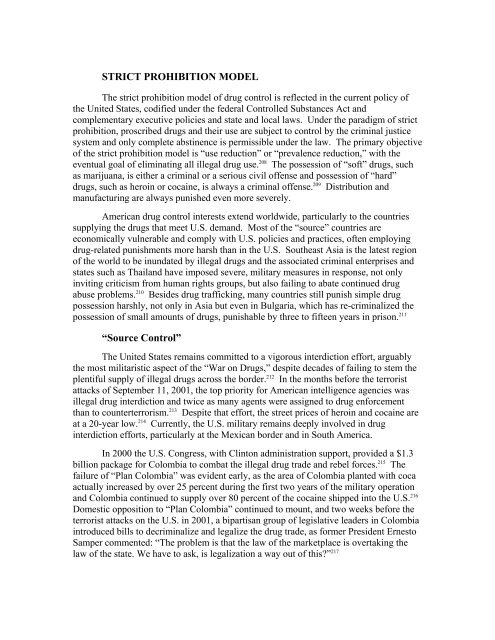Effective Drug Control: Toward A New Legal Framework
Effective Drug Control: Toward A New Legal Framework
Effective Drug Control: Toward A New Legal Framework
Create successful ePaper yourself
Turn your PDF publications into a flip-book with our unique Google optimized e-Paper software.
STRICT PROHIBITION MODEL<br />
The strict prohibition model of drug control is reflected in the current policy of<br />
the United States, codified under the federal <strong>Control</strong>led Substances Act and<br />
complementary executive policies and state and local laws. Under the paradigm of strict<br />
prohibition, proscribed drugs and their use are subject to control by the criminal justice<br />
system and only complete abstinence is permissible under the law. The primary objective<br />
of the strict prohibition model is “use reduction” or “prevalence reduction,” with the<br />
eventual goal of eliminating all illegal drug use. 208 The possession of “soft” drugs, such<br />
as marijuana, is either a criminal or a serious civil offense and possession of “hard”<br />
drugs, such as heroin or cocaine, is always a criminal offense. 209 Distribution and<br />
manufacturing are always punished even more severely.<br />
American drug control interests extend worldwide, particularly to the countries<br />
supplying the drugs that meet U.S. demand. Most of the “source” countries are<br />
economically vulnerable and comply with U.S. policies and practices, often employing<br />
drug-related punishments more harsh than in the U.S. Southeast Asia is the latest region<br />
of the world to be inundated by illegal drugs and the associated criminal enterprises and<br />
states such as Thailand have imposed severe, military measures in response, not only<br />
inviting criticism from human rights groups, but also failing to abate continued drug<br />
abuse problems. 210 Besides drug trafficking, many countries still punish simple drug<br />
possession harshly, not only in Asia but even in Bulgaria, which has re-criminalized the<br />
possession of small amounts of drugs, punishable by three to fifteen years in prison. 211<br />
“Source <strong>Control</strong>”<br />
The United States remains committed to a vigorous interdiction effort, arguably<br />
the most militaristic aspect of the “War on <strong>Drug</strong>s,” despite decades of failing to stem the<br />
plentiful supply of illegal drugs across the border. 212 In the months before the terrorist<br />
attacks of September 11, 2001, the top priority for American intelligence agencies was<br />
illegal drug interdiction and twice as many agents were assigned to drug enforcement<br />
than to counterterrorism. 213 Despite that effort, the street prices of heroin and cocaine are<br />
at a 20-year low. 214 Currently, the U.S. military remains deeply involved in drug<br />
interdiction efforts, particularly at the Mexican border and in South America.<br />
In 2000 the U.S. Congress, with Clinton administration support, provided a $1.3<br />
billion package for Colombia to combat the illegal drug trade and rebel forces. 215 The<br />
failure of “Plan Colombia” was evident early, as the area of Colombia planted with coca<br />
actually increased by over 25 percent during the first two years of the military operation<br />
and Colombia continued to supply over 80 percent of the cocaine shipped into the U.S. 216<br />
Domestic opposition to “Plan Colombia” continued to mount, and two weeks before the<br />
terrorist attacks on the U.S. in 2001, a bipartisan group of legislative leaders in Colombia<br />
introduced bills to decriminalize and legalize the drug trade, as former President Ernesto<br />
Samper commented: “The problem is that the law of the marketplace is overtaking the<br />
law of the state. We have to ask, is legalization a way out of this?” 217
















